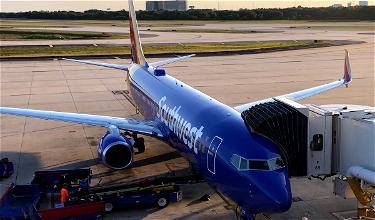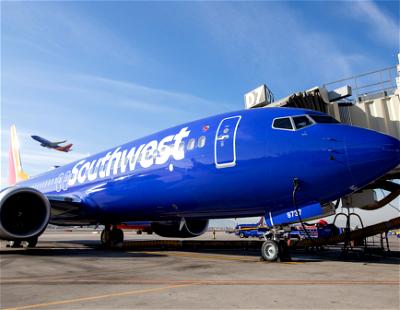You’d think we would’ve learned our lesson about a lack of separation between commercial aircraft and helicopters near airports from the fatal crash earlier this year, but here’s another incident that leaves us shaking our heads…
In this post:
Southwest 737 & medical helicopter have very close call
VASAviation has the story of an incident that happened on Wednesday, October 29, 2025, at Cleveland Hopkins International Airport (CLE). The incident involves a Southwest Boeing 737-700 that was approaching the airport as flight WN1333 from Baltimore (BWI), as well as a Metro Life Flight Eurocopter EC-145 (a medical emergency helicopter).
The Southwest jet was given clearance to land on runway 6L, while the helicopter was crossing the airspace from south to north. Long story short, the helicopter crossed directly in the path of the Southwest 737, to the point that the Southwest plane got a Traffic Collision Avoidance System (TCAS) alert, due to lack of separation. As a result, the Southwest pilots performed a go around.
The jet and the helicopter were at the same altitude, with less than half a mile separation. Honestly, I’d recommend just watching the below video, as VASAviation does such a good job with visualizations of these incidents. I think anyone watching the below video could see from well before the incident how this was going to unfold.
It’s sort of surreal to listen to this interaction
As everyone is aware, in January 2025 we saw an American Eagle jet and a military helicopter crash into one another near Washington National Airport (DCA). In retrospect, everyone said “how could something like this happen?” Well, there are quite some similarities between that incident and this one, in terms of the helicopter being told to maintain visual separation from the jet, only for that to not be sufficient.
What’s so strange about this incident is how there sort of seems to be a diffusion of responsibility. It’s not that the air traffic controller was distracted and didn’t see what was happening — quite to the contrary, he was acutely aware.
It’s normal for helicopters to transition busy airspace, and given that this was a medical helicopter, it also had high priority for taking a direct route. But still, this is absolutely wild on a variety of levels:
- The helicopter pilot claimed to have the Southwest plane in sight, but the controller kept reminding him of the location, so clearly this was all too close for comfort for him, though he remained silent
- The helicopter pilot claimed he was going to maintain visual separation from the Southwest 737, but obviously got way too close; the issue is, there’s no actual published guidance as to what visual separation means, in terms of acceptable distance in such a scenario
- The air traffic controller asked if the helicopter pilot could pass behind the Southwest 737, but he responded “it’d be better if we can go above it and in front of it if we can”
My takeaway here is basically that the helicopter pilot was saying “we have the traffic in sight, but we’re not actually going to do anything to avoid it.” Furthermore, the helicopter pilot was essentially saying “yeah, we’d like to pass in front of the Southwest 737, at the same exact altitude where planes usually fly at that point.” That should’ve raised some red flags, particularly for the controller, who knows exactly what altitude planes are going to be at on descent.
This is just a massive breakdown in communication across the board. Ironically the Southwest pilots were the only ones who didn’t have the traffic in sight, and they were the ones who called the go around due to the TCAS alert. Meanwhile the air traffic controller and helicopter pilot knew exactly how close they were, but… seemingly did nothing with that information?
I can’t help but think back to Nathan Fielder’s incredible show, The Rehearsal, and think that’s very relevant here. It’s inexplicable how the air traffic controller knew exactly what was going on, but chose to not take action.
Bottom line
A Southwest Airlines Boeing 737 approaching Cleveland Airport had a very close call with a helicopter. Bizarrely, both the air traffic controller and helicopter knew exactly what was going on, yet chose to do nothing about it. The Southwest pilots got a TCAS alert and performed a go around, but the jet and helicopter were dangerously close.
This communication breakdown is confusing under any circumstances, but is particularly unsettling in light of January’s fatal crash.
What do you make of this strange incident at Cleveland Airport?





There is a very simple explanation here - normalization of deviance.
Helicopters (and other slower moving aircraft) probably do these kinds of visual separations countless times each day near approach paths all around the country. It makes the controllers nervous to varying degrees but the vast vast majority of the time works out without anybody having to make emergency maneuvers.
This time things got too close.
But the issue is this happens in general.
What is being suggested here, that ATC personnel would let a collision occur because they are pawns in a political fight and therefore, don't care? The ATC personnel are still showing up even though they are not being paid. I would say that shows dedication and concern for providing public services even in these trying circumstances. Can we avoid beating up civil servants for doing their jobs?
'Watching' isn't usually a problem; so, I'd say, 'don't yuck someone else's yum,' but, if it's gonna 'hurt' others, especially without their consent, then that's a huge no-no.
Anyway, I'd think a mid-air collision probably hurts others without their consent.
Is it a conscious decision to not cover the AA transcon devaluation?
@ Jack -- You're talking about an increase to the non-saver award costs in premium cabins on transcon flights? If so, I don't really view that as a huge story. The cap on how much awards cost has increased considerably over time. But it seems saver awards are still reasonably priced, when available?
I had to check FlightAware to figure out what time of day (or night) this happened. Apparently SWA1333 landed at 2:34pm, on time, at Cleveland.
The sooner ATC is completely automated, the better. The computers can all talk to each-other and remove the human element altogether.
No, mate. Invest in better tech and equipment, but humans should always be involved, even if as mere oversight. We should still want experienced pilots up-front, and professionals in-the-tower.
The transcription is incorrect at a crucial point before the Southwest plane turns to final. ATC asks the helicopter for 3000' not 2000'. But helicopter responds with maintaining 2000' with a stress on the 2. Either the helicopter misheard as in the transcription or he insisted on 2000 and wanted to make sure ATC heard the 2. Since ATC made no attempt to correct, the helicopter would assume he was fine at 2000'.
Visual separation...
The transcription is incorrect at a crucial point before the Southwest plane turns to final. ATC asks the helicopter for 3000' not 2000'. But helicopter responds with maintaining 2000' with a stress on the 2. Either the helicopter misheard as in the transcription or he insisted on 2000 and wanted to make sure ATC heard the 2. Since ATC made no attempt to correct, the helicopter would assume he was fine at 2000'.
Visual separation is typically easier for horizontal distance than vertical which is difficult to judge. With the helicopter assuming they were fine in vertical separation from previous exchange, they would have thought they were passing in front (with visual separation) and above assuming the plane would be lower.
Southwest may have lost the helicopter visual under the nose on final.
Two major slipups. Not sure why they allowed the helicopter to cross over short final rather than over the runway vectoring it that way. Combined with ATC not being aware of the insufficient vertical separation for that flight path even before the Southwest had turned final.
Second, ATC should also have been become aware of the converging paths even before the TCAS warning on the Southwest.
Did ATC think the helicopter was at 3000 as had been instructed not seeing the transponder read out?
There is more than just communication breakdown at play here
@ GV -- You're talking about 41 seconds into the video? I distinctly hear the controller saying 2,000, but maybe I'm misunderstanding?
DEI
Oh stuff a sock in it.
Why not 'tell us how you really feel' because anytime I see this b.s. it's just thinly-veiled hate. Like, go-ahead, use the 'hard-r' on here, so others are not confused at what you're suggesting.
Sooooo do you just that to explain everything you don’t like? Maybe you you should try harder in life and stop blaming others for your failures.
Maybe the ATC controller thought they weren't being paid enough to care (or, paid at all).
Yup. Last bi-weekly paychecks were mid-October; this incident happened October 26, 2025. Republicans should immediately negotiate in-good-faith with Democrats for a bi-partisan budget. Keep people safe. Pay ATC, FAA, TSA; fund all the programs; healthcare is a human right.
Agreed they should be paid for working. But to suggest that 150-175 lives should be lost is insane.